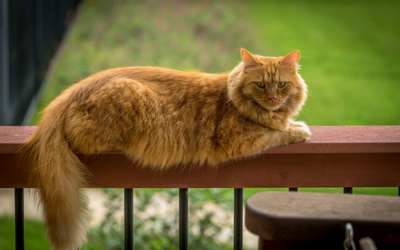
With the arrival of warm weather comes the time when we throw our windows wide open and enjoy time relaxing on the balcony with the door left open. Out comes your cat to visit while you enjoy the late evening breeze. But open windows and free-access balconies can pose a serious danger to curious kitties.
What is high-rise syndrome?
Each year as the temperature rises, so too does the incidence of “high-rise syndrome”. High-rise syndrome is a term that was coined in the early 1980’s when an animal treatment center in New York City (Animal Medical Center) treated over a hundred cats during a five month period that had fallen out of a “high-rise”. The cats that were brought to the clinic had chest trauma, head and facial injuries, and limb fractures.
Do cats jump or fall?
Cats like to sit in high places which can translate into a dangerous situation. Cats have no fear of heights and enjoy sitting perched in high places. Cats can and do fall off balconies quite often, especially if they are focussed on a bird or squirrel, are startled by a noise, or can even roll off a sill or railing while asleep. Although cats can cling to tree bark with their claws, they cannot grip so easily onto the slippery surfaces of window ledges and balcony railings, allowing them to easily slip off and fall. Cats don’t usually jump off of balconies, but are attempting to jump to something when they lose their balance or miss their landing and fall.
Many cat owners think their cat won’t fall, or if she does, she will “land on her feet”. Cats’ reflexes do allow them to turn right-side-up as they fall and they often do land on their feet if they fall from a height greater than 1-2 feet. Cats that fall from a first or second story will likely right themselves, but are not necessarily perfectly positioned to land without incident. How they fall or what surface they fall on will determine the nature of an injury, which can sometimes be severe. Falls from greater heights allow the cat to spread out in the “flying squirrel position” which slows the speed of their fall. Cats that survive the initial fall, have a high survival rate, but they often sustain traumatic injuries. Not all cats survive high-rise falls.
What to do if your cat falls out of a window
If your cat does fall out of a window or off a balcony, take her immediately to your veterinarian or a veterinary emergency clinic. Even if your cat appears to be fine, she may have internal injuries including heart and lung bruising, head injuries, a ruptured bladder, and fractures of hips, pelvis, jaw, and limbs. The survival rate is good for high-rise syndrome victims IF they receive immediate veterinary care.
How can I prevent high-rise syndrome from happening to my cat?
- Keep window screens tightly secured
- Close windows if you don’t have screens
- Open the top part of the window rather than the bottom if the windows are double-hung
- Do not allow your cat onto your terrace or balcony
- Ensure there are no gaps around window air conditioning units that a cat could squeeze through
Enjoy the summer breeze safely!
